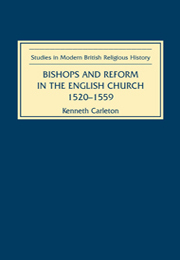Book contents
- Frontmatter
- Contents
- List of Illustrations
- Dedication
- List of Abbreviations
- Acknowledgements
- Introduction
- 1 Theologies of Episcopacy in mid-Tudor England
- 2 Models of Episcopal Office
- 3 Bishops of the English Church, 1520–1559
- 4 The Bishop and Preaching
- 5 Bishops and the Provision of Education
- 6 Prayer and Sacrifice: the Life of the Bishop
- 7 Episcopal Activity I: the Eradication of Heresy
- 8 Episcopal Activity II: the Propagation of the Ministry
- 9 Conclusion: the Old Episcopate in a New Order
- Appendix I Prosopography of the bishops in office, 1520–1559
- Appendix II The dioceses
- Appendix III The education of the bishops
- Appendix IV The bishops of Sodor and Man
- Bibliography
- Index of Scriptural References
- General Index
- Frontmatter
- Contents
- List of Illustrations
- Dedication
- List of Abbreviations
- Acknowledgements
- Introduction
- 1 Theologies of Episcopacy in mid-Tudor England
- 2 Models of Episcopal Office
- 3 Bishops of the English Church, 1520–1559
- 4 The Bishop and Preaching
- 5 Bishops and the Provision of Education
- 6 Prayer and Sacrifice: the Life of the Bishop
- 7 Episcopal Activity I: the Eradication of Heresy
- 8 Episcopal Activity II: the Propagation of the Ministry
- 9 Conclusion: the Old Episcopate in a New Order
- Appendix I Prosopography of the bishops in office, 1520–1559
- Appendix II The dioceses
- Appendix III The education of the bishops
- Appendix IV The bishops of Sodor and Man
- Bibliography
- Index of Scriptural References
- General Index
Summary
The office of bishop was central to the Church from its earliest days. By the second century, the fundamental structural principle of the local ecclesial community was that of a single bishop, surrounded by a college of clergy, who together governed and served the people of the local Church or diocese. Together the bishops ruled and governed the whole Church, binding it together in unity (Cyprian called the bishops its ‘glue’). Though splits and schisms appeared over the next fourteen hundred years, the greatest and most enduring being the Great Schism between east and west in the eleventh century, the fundamental principle of the single bishop at the head of the local Church remained the touchstone of the authentic Christian community. The late medieval bishop stood at the centre of a complex web of relationships. He was at one time both the king's man and the pope's, owing allegiance to both and deriving from each some of his authority and power. Dependent upon him to a greater or less degree were the clergy of his diocese, his lay officials and stewards, and the whole panoply of secular estate which had grown over the centuries around the office of a lord and pastor. The bishop sat in the Upper House of Parliament amongst his peers, Lords temporal as well as other Lords spiritual, by virtue of the temporal baronetcy which was attached to his see and which was conferred upon him around the time of his appointment.
- Type
- Chapter
- Information
- Publisher: Boydell & BrewerPrint publication year: 2001



